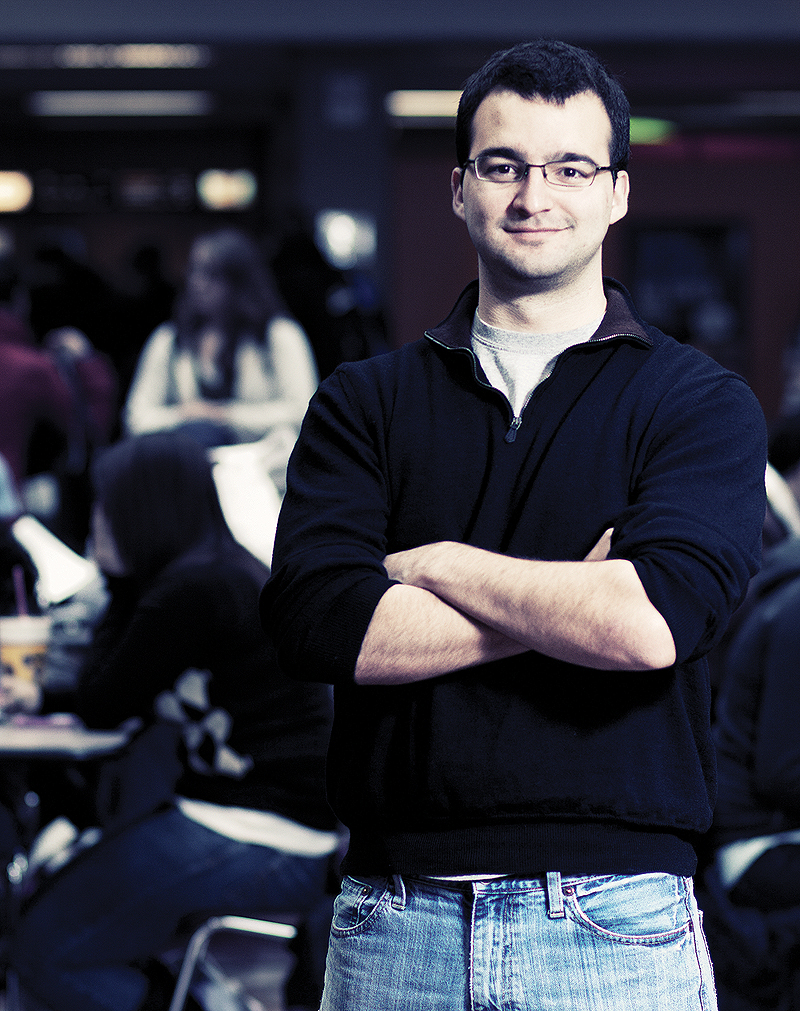- The cool factor
- Article by Alain Latour on February 16, 2010
-
SOMEWHERE IN THE WORLD, A BOY WILL OGLE AT A PAIR OF ADIDAS SNEAKERS, A GROWN MAN AT AN iPHONE, A GIRL AT AN ARMANI DRESS, AND THEY WILL ALL WISH THEY HAD IT.
They won’t do it because Adidas is better than Nike, or an iPhone better than a BlackBerry, or an Armani dress better than a Hugo Boss dress.They’ll do it because advertising persuaded them that that specific product would make them cool.
Many an Apple fan (a group that I belong to) would likely disagree. They would point to a Mac’s ease of use and to its ability to work without crashes. And they would be right, in my opinion. Still, there’s no denying that Apple has marketed itself as a cool brand, although a cool factor, objectively speaking, should carry little weight in deciding which computer to buy—or, for that matter, which sneakers.
Be cool
Advertisers love the cool factor. It’s hard to define and easy to exploit, which comes in handy when promoting the subjective qualities of a product instead of its objective qualities. All objects (and all products) have a symbolic value and a functional value. Advertising used to be about the functional value, that is, about the concrete reasons why you should buy a specific product. Over the years, however, the emphasis switched to providing products with symbolic connotations. The reason is that symbolic connotations help sell products, whose truly relevant features are almost indistinguishable from one another. Advertiers do this by creating a subjective difference in your mind between a product and the competitors’.Let’s take cars for example. They all have four wheels and work fairly well at transporting people from point A to point B. Yet how many of us would hesitate to proclaim a BMW a better car than a Toyota? More importantly, how many of us would choose to buy a BMW over a Toyota, if money was no object? The answer is, I suspect, a number far lower than those would acknowledge that a cooler and faster car doesn’t equal a mechanically better one.
This is partly why many ads try to sell expensive products—products that are not really essential for us. Wristwatches, for instance, are convenient, but not really essential, especially today, when digital clocks wink at us from computers screens and microwaves and cell phones and subway displays. Yet many people pay thousands of dollars for a Rolex, even though a $50 digital Timex is actually more accurate than any Swiss-certified chronometer. In their mind, the cool factor justifies the high cost of the Rolex (although in this case “exclusive” is probably a better word than “cool.”) In fact, the Rolex’s high cost has become one of the main reasons why it’s cool or exclusive to own one.
Nowhere is this phenomenon more prominent than in the fashion world. Consumers lavish on brands just because a celebrity wears them (or is paid to say they do) or because they have been persuaded that that brand will make them cool (think of the little green crocodile).
Run for cover
We are being bombarded with ads. In 2006, US $391 billion was spent worldwide on advertising. The industry may be suffering, what with declines in TV-viewing and newspaper sales, but it is also fighting back, embracing the Internet, which it initially saw as its enemy, and studying market segments more closely than ever.I’m not suggesting that advertising is inherently evil. In fact, it has allowed many products to come to us for free—from radio stations and web applications to iPhone apps such as Shazam. This very magazine would not have happened if it weren’t for the ads you’ve flipped through. And now that advertising in the media is compromised, many newspapers, including the venerable New York Times, will likely have to charge readers for online access. Ironically, some of them will no doubt be the same ones who had downloaded browser extensions to disable ads.
Some experts doubt that advertising will survive in the long run, when consumers will get most, if not all, of their entertainment from the Internet. That is beyond the scope of this article. One thing is clear: while mass advertisement may fade, there will always someone trying to persuade
to buy something. This is how they do it.HOW ADVERTISERS LURE US
Implications
Advertises do a lot implying. Implying things rather than outright stating them allows advertisers to make people believe their product is cool, or better, or healthier, or faster without actually saying so. More importantly, it allows them to do so without violating regulations for making unsubstantiated claims.
One of the most effective ways to create an implication is by juxtaposing phrases, like “Get a good night’s sleep. Get [insert sleeping pill name] nighttime.” Another (trickier) way relies on presenting the same information in another way. For example, studies show that for products with a fairly large amount of an ingredient perceived to be unhealthy, people think the whole product is healthier when the good ingredient is advertised first (“75% fat free” rather than “25% fat”). Thus the ad implies that the product is healthy without actually saying so.Advertisers also use bare comparatives, for example, “shampoo X gives you shinier hair.” But shinier than what? And how much shinier?
Non-facts, selective facts and minimal facts
Advertises carefully choose which features to promote. They may say a car is fast, but neglect to mention it uses more gas. They could also say a blender has 15 speeds—but is that better than just three?As for non-facts these are statements that sound good and imply a certain quality but are completely unverifiable, such as “timeless appeal.”
Word Play
This is often an easy puzzle. Solving it gives the audience a sense of accomplishment. Other times it’s simply a rhyme, which makes the ad easier to remember.John Kuraoka, a freelance advertising copywriter, argues, “If your headline can be used for a different product, but it is still clever, then it is probably word play.” By that token, “Some explorers insisted on the best navigation systems,” an ad used by a Swiss watch company, would qualify as word play. It could refer to a navigation system (whatever that is) or to the watch they are advertising. Another example: a nail polish “Puts beautiful nails at your fingertips?”
Yet another trick is to use words with luxurious connotations. “Suite” for room, “generous” for “large,” “appointed” for “decorated.”
Associations
In a luxury watch ad, connotational meaning was tweaked to make readers associate the watch with luxury: “Satin-finished screws” (do they mean shiny?), “finely worked champagne dial,” “diamond treated applied indexes,” “deployante buckle.” Simpler words might have been chosen, but they would not have made the product seem as luxurious or exclusive.Photo/Edward Cai.
Inside
- Putting your best foot forward
Maybe the two of you will hit it off, or maybe this person will suck you into a vortex of never-ending small talk or hostility.
- more >
-

- This magazine probably comes as a surprise to most of you.
As far as I know, The Medium never had one before, although other university papers do. Nor has there been a demand for it—try as I may, I can’t hear students clamouring for a Medium Magazine outside of this office.
So why did we do it? Why now?
- more >
-

- Wardrobe essentials for him and her
Whether it’s wool-blend for winter or a lighter material to carry you through spring and fall, a double-breasted coat is a must-have
- more >
-

- Best of the nation
As we enter a new decade, The Medium Sports Editor Andrew Tysiak takes a look back and recaps the top 5 Canadian athletes of the 2000s.
- more >
-

- From North to South
Remember your first day at UTM? Remember feeling like you’d never find your classes when you realized they took place in more than one building? Here’s your guide to finding your way around utm.
- more >
-

- Healthy breakfast options
This is a fast and easy choice for breakfast, but still contains everything you need to start your day off right.
- more >
-

- So you wanna buy a camera?
In the market for a new camera? Medium Magazine’s Photo Editor Matthew Filipowich draws out what you should buy.
- more >
-

- Last chance for romance
Nova Scotian Rich Aucoin sits, reads, slides and jumps with us in our first-ever issue of Medium Magazine.
- more >
-

- So you wanna take photos?
Now that you’ve bought or borrowed your camera (FOLLOWING THE infographic from the magazine’s last issue) you want to take awesome photos.
- more >
- About The Magazine
What do you like?
We must have asked over one hundred people that very question, and this magazine is the answer.
Newspapers can be limiting. You are obligated to write a certain way, to only cover certain things, and everything must follow a specific grid. Sometimes this can help foster creativity, being forced to work within parameters. But after 36 years of publishing, we feel that it’s time to step outside of the box.
Producing a magazine was a no-brainer. We were free to write how we felt and to present it in a more accessible way.This magazine was composed with you in mind. That’s right. We went through a ton of ideas, picking out the good, trying to cater to everyone’s preferences and make it as approachable as possible. Hence this brand new website.
We suggest you take a look around. You might find something unexpected.
- more >
-

- Confessions of a Stanley Cup champ
Bruce Driver is one of the lucky few who realized his dream of making it into the NHL. We asked him about it.
- more >
Top Feature
Featured Articles
-

- How to plan a trip abroad: Student edition
You’ve actually got to plan this dream vacation, and though you won’t have it all figured out in a matter of days, you have to start somewhere.
- more >
-

- Young entrepreneurs: Where are you?
Right off the bat, I’ll get right to the goods. Most young entrepreneurs suck: they are filled with lofty, unrealistic goals and typically serve a selfish or ego-driven hunger… usually to impress their friends on the fourth floor of the UTM library.
- more >
-

- Jian Ghomeshi’s Real Cool World
WAKING UP AT 6 A.M. FOR A 12-15 HOUR WORK DAY MAY SEEM CRAZY TO MOST OF US BUT TO JIAN GHOMESHI THAT’S A TYPICAL DAY AT THE OFFICE. An award winning broadcaster, the host and co-creator of the national daily talk program, Q, on CBC Radio One, Jian also manages the career of Canadian […]
- more >



